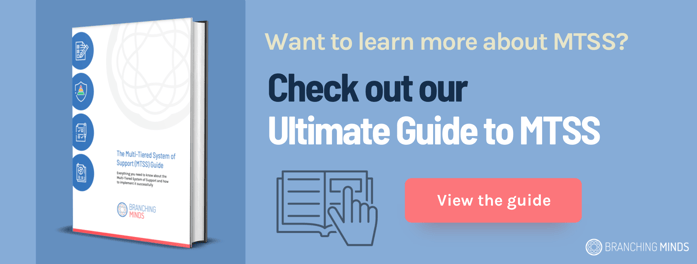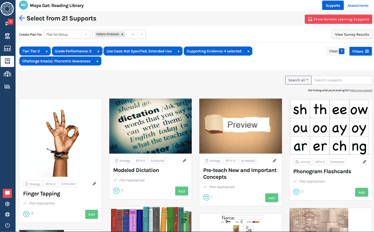
Top 5 Most Common MTSS Reading Programs Used in 2020
An effective core reading curriculum, as well as differentiated support for struggling readers, is essential for any MTSS practice. But with the hundreds of reading programs available for districts and schools, it can be difficult to determine which one is the most effective.
Below we outline the five most frequently used reading programs and platforms by Branching Minds school districts throughout 2020. We provide a critical overview of the research and evidence base for these programs and outline what educators should be aware of when implementing these approaches. We also include some general recommendations for teachers, principals, and administrators to ensure that their reading curriculum is effectively meeting the needs of all students.
Fountas and Pinnell Leveled Literacy Intervention
F&P LLI is by far the most commonly used program for Tier 2 and 3 students on the Branching Minds platform; in 2020 it was used to support over 5000 students. Despite its popularity, the program has been highly criticized for years by educators and cognitive scientists.
One of the main sources of criticism is the program’s focus on a method of reading known as “cueing”, where students are trained to use pieces of information from the text to “read” a given word. This method runs counter to a large body of research showing that strong readers use letter-sound correspondence and phonemic awareness to decipher words. Although F&P does include phonics in the curriculum, it is not as systematic and explicit as other reading programs.
Another criticism of the program has to do with the research evidence supporting the program’s effectiveness. Although F&P does fall into the “Strong” ESSA category, the program has only been shown to be effective for students in kindergarten and first grade. Research has also shown that the program may lead to adverse reading outcomes for students in older grades. It has been theorized that the methods used in F&P may provide temporary skills for younger children to improve in early reading, but they are not providing a strong enough foundation for children to show reading success in the future years, especially as students are expected to read and understand more complex words and sentences. In other words, the F&P approach may not hold up over time.
Finally, one of the most troubling criticisms of F&P is that some of the content in the leveled readers perpetuates racist stereotypes. A recent study, which used critical content analysis, found that books included in Level U of F&P LLI presented people of color as inferior, deviant, and helpless, while white characters were depicted as heroic, determined, innovative, and successful.
Not only does this study raise serious questions about whether F&P books belong in any classrooms, but it points to a larger issue with educational content that may exist beyond just the F&P program. Nevertheless, if F&P is the go-to reading program at your school or district, it may be time to take a more critical look at the content as well as how it is serving your students.
iStation
iStation is another popular reading program that has endured its fair share of criticism. The program includes a universal assessment, called ISIP, that is used to place students in interactive online instruction aligned with their learning needs. One of the biggest criticisms of this program is its over-reliance on technology.
While independent practice through computer-based programs can be beneficial for students, there needs to also be interactions between students and teachers, so that teachers can adequately monitor how students are reading and provide real-time feedback and dialogues about the text. This is especially critical during the early elementary years, when these instructional interactions can provide students with foundational reading skills.
Another issue with iStation is the lack of independent research supporting its claimed impacts on student learning. The studies also lack a proper control group and only show correlations between the student’s use of iStation and their reading outcomes. Despite these inconclusive findings, some states have adopted iStation as their primary education platform. So some educators might not have a choice in terms of whether or not they use this program. But for students who require support at the Tier 2 or 3 level, it is important to go beyond this online platform and make sure they are getting the small group or one-on-one support that they need to meet their grade level expectations.
| Related Resource: Supporting English Language Learners, Bilingual, and Dual-Language Students in MTSS |
Achieve3000
Achieve3000 is another popular online program that also uses its own assessment system to provide students with instruction tailored to their reading level. A key benefit of the Achieve3000 program is its explicit use of research-based approaches to reading, such as a multi-sensory approach and systematic phonics linguistics instruction. Although most of the content is presented individually to students online, there is also a direct instruction component as well as lessons that can be delivered to a whole class, in small groups and one-on-one.
Finally, the platform is also meant to adapt to the needs of individual learners while also providing all learners with access to grade-level literacy content. This ensures that all students can participate in whole class discussions related to the readings. In other words, Achieve3000 can be used to support students across tier levels.
The research findings for Achieve3000 are also promising. In a large randomized controlled trial, with students from both urban and suburban school districts, the implementation of Achieve3000 had positive effects on students in middle and high school, specifically 6th and 9th-grade students. However, only small-scale studies have been conducted with elementary students showing positive but smaller effects on reading outcomes.
Interestingly, one larger study with elementary students was unable to find significant effects due to poor overall implementation of the program (a summary of all the Achieve3000 studies can be found here). Overall, Achieve3000 appears to provide students with adequate reading support and is likely a good program for middle and high school students. Benefits may be seen for elementary students as well, but proper implementation is essential.
Wilson Fundations
Wilson Fundations is a Tier 1 and 2 reading program for early elementary (K-3) students. The program is grounded in reading research, highlighting the importance of phonics, fluency, vocabulary, and comprehension. It also uses a multi-sensory teaching approach that is structured, systematic, and cumulative. Unlike some of the programs outlined above, Fundations is primarily implemented directly through the classroom teacher and not online, although they currently have an online resource hub that can be used for virtual instruction. In addition to being used as a whole-class supplementary program, Fundations can be used as an early intervention for students who are struggling with reading and require Tier 2 support.
Several studies have been conducted on the Wilson Fundations program, but unfortunately, there haven’t been any randomized controlled trials. So although the existing research does show that students who receive the program show gains in their reading skills, the actual impact of the program is still unknown. Other reviews of the program have criticized its lack of opportunities for independent student practice. Nevertheless, the strong adherence to reading science principles makes this program a good starting point for early readers, but teachers may find that they need to provide students with additional support and scaffolding beyond what the program provides.
i-Ready
i-Ready is well known for its universal screeners and benchmarks, but they also provide a K-8 reading program. The program is primarily implemented online and provides personalized lessons that are based on students' performance on the i-Ready diagnostic assessment. The program also includes Tools for Instruction, which are lesson plans provided to teachers that are meant to address the specific learning gaps of their students. These lessons can be delivered in small groups and one-on-one with students who are struggling with reading skills. They can also be used with an entire class to clarify more complicated concepts and skills. The content is also based on research and best practices and focuses on phonics, word recognition, vocabulary, and reading comprehension.
Quasi-experimental research studies (i.e., the control and treatment groups were not selected at random) conducted on the i-Ready program have shown that students who did receive the program showed significant improvements in their reading outcomes. This was found in a study with early elementary (K-2) students as well as middle school students (6th grade); however, no positive effects were found for students in grades 3-5. Importantly, these studies did not look at the outcomes for specific subgroups. There is some preliminary evidence that the program does benefit students with special needs, but this area needs further examination in order to draw conclusions.
Recommendations for Supporting Students in Reading
The main takeaway from the summaries above is that there is no perfect reading program. While many of these programs market themselves as comprehensive solutions, the truth is there is no “one size fits all” approach. This probably comes as no surprise to teachers who have witnessed firsthand how many programs don’t meet the specific needs of all students. To conclude, here are some things to consider when deciding on which reading programs and practices to implement in MTSS.
-
Understand the specific needs of the student
Many students struggle with reading, but the cause of these issues can be quite different depending on the individual. Given the underlying issue, some approaches may be more or less effective for certain students. Sometimes the areas of concern can be determined through the results of universal screeners and assessments. Other times more observations of the student and their reading abilities is needed.
While many programs try to address this through the use of online diagnostics and adaptive content, these programs may still miss the individual needs of certain students, social-emotional competencies, and other factors that influence their ability to develop their reading skills. This type of problem-solving requires ongoing interactions between students and teachers as well as collaboration among educators to determine the best course of action.
-
Shift from an emphasis on programs to a strategies-based approach
Sometimes packaged reading programs provide too much structure and teachers can fall into the habit of simply following prescribed lesson plans without ensuring that students are building essential reading skills. That is why many educational experts have recommended a strategies-based approach to reading, as well as other topics. One example of this is the Strategic Instruction Model, which focuses on key learning strategies and teaching tools which scaffold students towards independent problem-solving and learning.
And the good news is that this method has strong research evidence backing its effectiveness. There are also many evidence-based reading strategies that have been shown to significantly improve outcomes for struggling readers. An important part of this is ensuring that teachers understand and have proper training on the implementation of these instructional strategies. -
Consider the research evidence
Although it can be difficult to decipher the true meaning of the results from large experimental studies, it's important to pay attention to certain aspects of the research in order to understand a program’s effectiveness.
As we’ve outlined above, some programs may exhibit “strong” research evidence, but only for specific grade levels. This is not a surprise given that the learning needs of children and adolescents change as they develop. It may be that middle and high school students do better with approaches that foster independence while younger elementary students require more hands-on approaches. In addition, it is much easier to draw conclusions about programs and practices that have been evaluated in an experimental or quasi-experimental study (i.e., a control group was included), compared to studies that just showed student improvement over time without any type of comparison or control.
Finally, if you really want to critically evaluate the quality of research on a program, take a closer look at the assessments used to measure student growth and achievement. Some programs boast positive outcomes for students, but their study used unreliable and unvalidated measures of reading achievement; in other words, their findings are meaningless.

Dr. Essie Sutton
Essie Sutton is an Applied Developmental Psychologist and the Director of Learning Science at Branching Minds. Her work brings together the fields of Child Development and Education Psychology to improve learning and development for all students. Dr. Sutton is responsible for studying the impacts of the Branching Minds on students’ academic, behavioral, and social-emotional outcomes. She also leverages MTSS research and best practices to develop and improve the Branching Minds platform.
Related Posts
Tagged: Interventions and Learning Supports' Strategies







Comments (1)